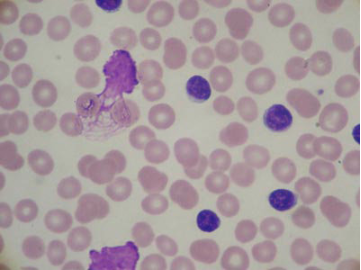Smudge Cells in Chronic Lymphocytic Leukemia
/Smudge Cells in Chronic Lymphocytic Leukemia
Chronic lymphocytic leukemia/small lymphocytic lymphoma (CLL/SLL) is a mature B cell neoplasm characterized by a progressive accumulation of monoclonal B lymphocytes. The lymphocytes are predominantly small and mature appearing, and due to increased fragility they may form “smudge cells” on the peripheral smear (as pictured here). The frequency of smudge cells can have prognostic implications in CLL. A study out of Mayo Clinic found that >30% smudge cells is associated with more aggressive form of CLL. Smudge cells can also be due to infectious causes or simply due to an old blood sample.
CLL is recognized based on increased absolute lymphocyte count on CBC. Patients can describe B cell symptoms and can have hepatosplenomegaly and lymphadenopathy. Patients are often immunosuppressed due to hypogammaglobulinemia and may present with recurrent bacterial infections.
One of the significant complications of CLL is leukostasis. While leukostasis is more common to AML & CML with WBC >100x10^9/L and symptoms of impaired tissue perfusion, it can occur in CLL when WBC >400x10^9/L. Patients can present with pulmonary (dyspnea, hypoxia, falsely reduced PaO2), neurologic (HA, vision changes, AMS), and fever. This is a medical emergency! 20-40% of patients ultimately die within 1 week of presentation. Treatment: aggressive hydration and cytoreduction (via induction chemotherapy, hydroxyurea, versus leukapheresis).

